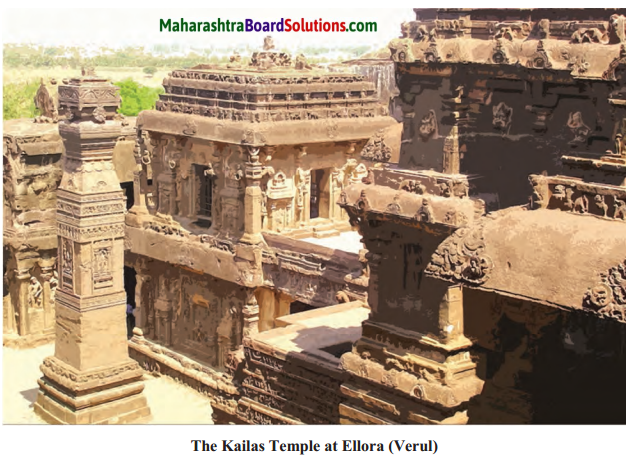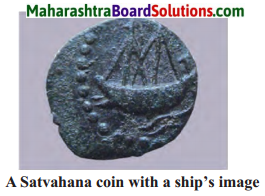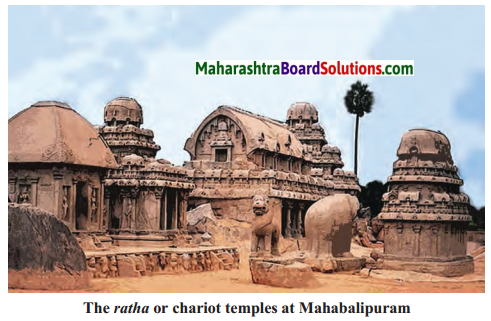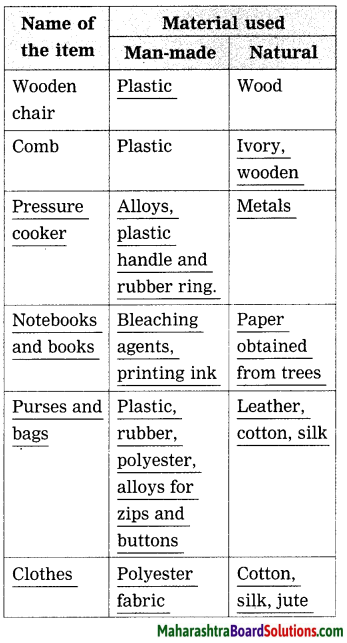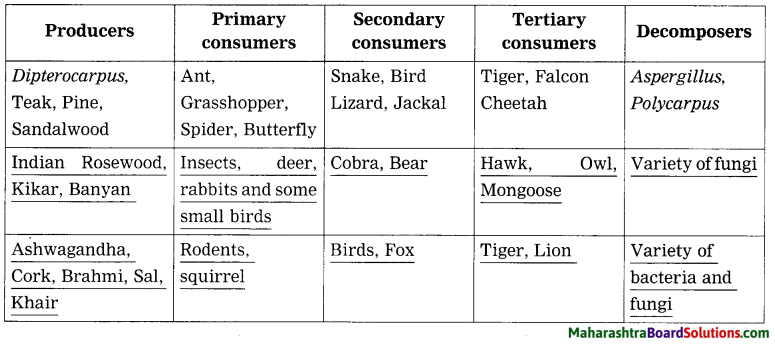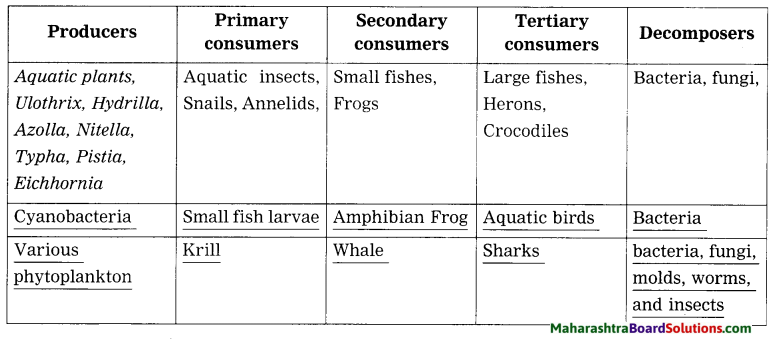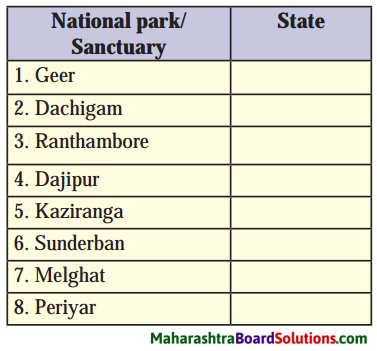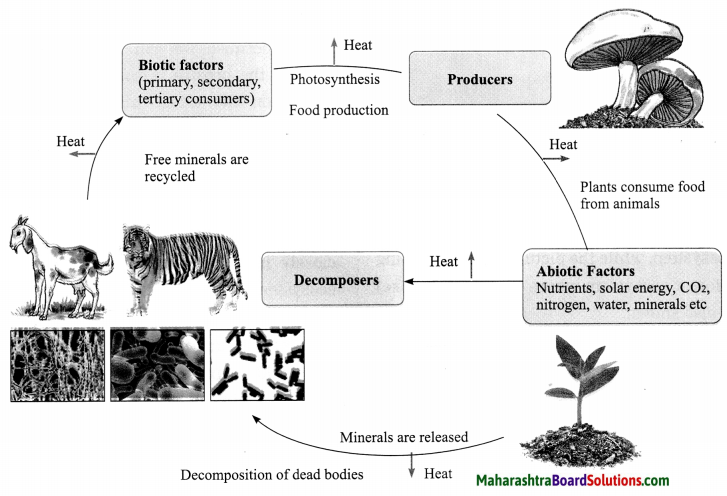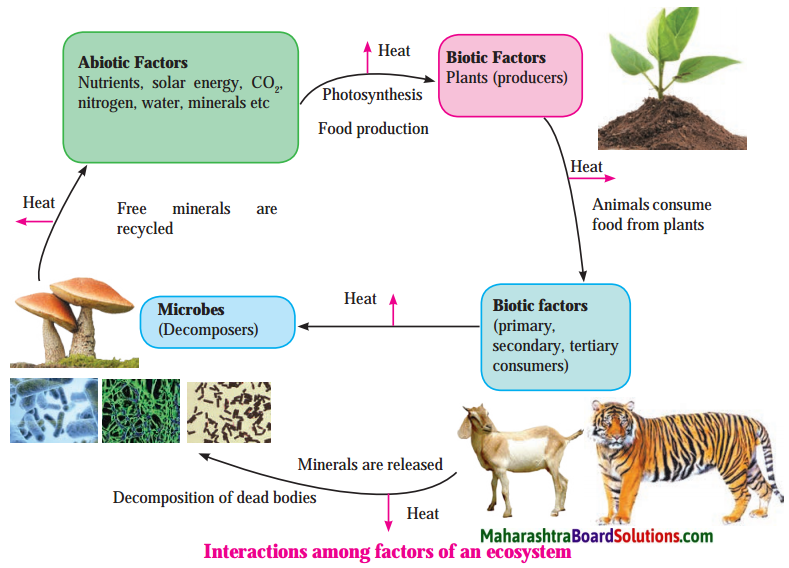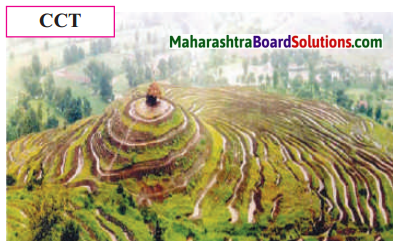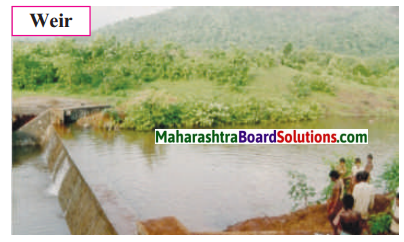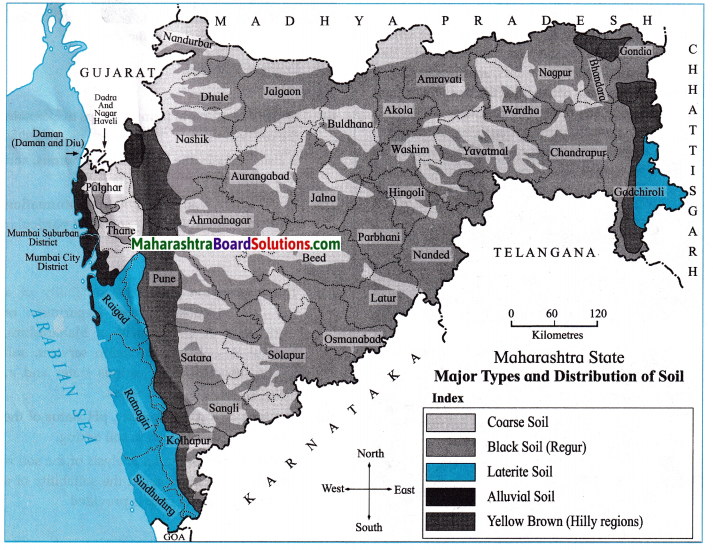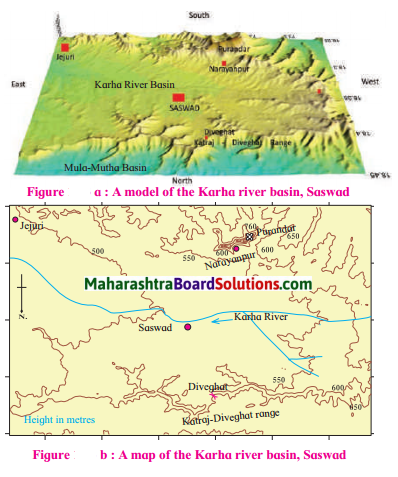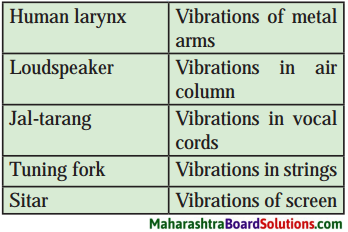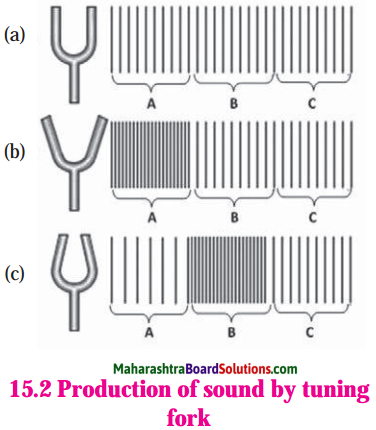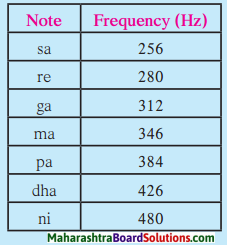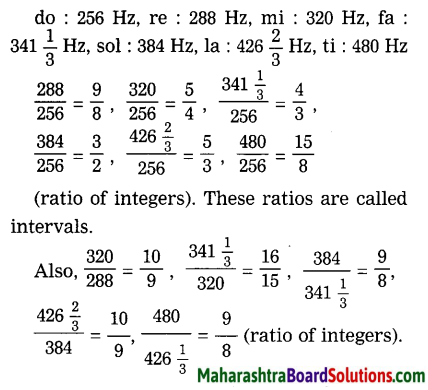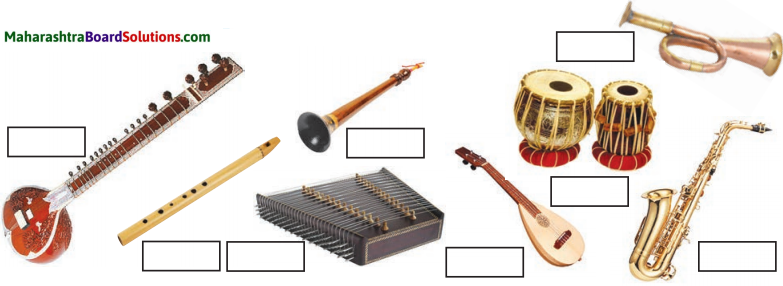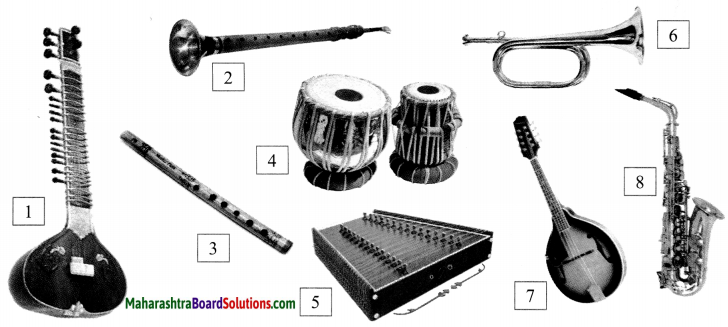Balbharti Maharashtra State Board Class 6 History Solutions Chapter 10 Ancient India: Cultural Notes, Textbook Exercise Important Questions and Answers.
Maharashtra Board Class 6 History Solutions Chapter 10 Ancient India: Cultural
Class 6 History Chapter 10 Ancient India: Cultural Textbook Questions and Answers
1. Answer in one sentence:
Question 1.
Make a list of ancient Indian universities.
Answer:
The ancient Indian universities are Takshashila, Vamasi, Valabhi, Nalanda, Vikramshila and Kanchi.
Question 2.
Make a list of the Indian goods that were in demand in foreign countries.
Answer:
Indian goods like fine textiles, ivory, precious stones, spices, beautifully made earthen ; pottery were in great demand in foreign countries.
![]()
2. Name the following:
Question 1.
Epics and poetic composition of ancient India.
Answer:
Epics Silappadhikaram and Manimekhalai and Arsha epics Ramayana and Mahabharata and Paumchariya a poetic work are composition of ancient India.
3. Fill in the blanks:
Question 1.
The epic Ramayana was composed by rishi
(a) Vyas
(b) Valmiki
(c) Munni
Answer:
(b) Valmiki
Question 2.
The science of Indian medicine is called
(a) Ayurveda
(b) Homeopathy
(c) Alopathy
Answer:
(a) Ayurveda
Question 3.
Thousands of students could live at the University.
(a) Kanchi
(b) Takshashila
(c) Nalanda
Answer:
(c) Nalanda
![]()
4. Answer in brief:
Question 1.
Explain what is meant by ‘Tipitaka’.
Answer:
Tipitaka is a Buddhist religious text written in Pali. It contains three categories of texts.
- Sutta Pitaka
- Vinay Pitaka
- Abhidhamma Pitaka
Question 2.
What is the message of the Bhagwad Gita?
Answer:
- The Bhagwad Gita tells us that each one of us should do our duty without expecting rewards.
- It also says that the path of devotion to God is open to all.
Question 3.
What aspects does Ayurveda take into account?
Answer:
Ayurveda is a very old traditional Indian medical science. Ayurveda not only seeks to understand the symptoms, diagnosis and treatment of an illness but also takes into account the prevention of the illness.
Question 4.
What is meant by Sangham Literature?
Answer:
Sangham means a gathering of learned men. The literature that is compiled in such gathering is known as Sangham literature.
![]()
5. Discuss:
Question 1.
Art and architecture of the Mauryan and Gupta period.
Answer:
- Indian architecture reached its peak during the Mauryan and the Gupta periods.
- The stone pillar erected by Emperor Ashoka at various places are excellent examples of Indian sculpture.
- The stupa at Sanchi and cave sculptures at Karla, Nashik, Ajanta, Ellora, etc. show that the same tradition advanced even further.
6. What would you do ?
Question 1.
How would you obtain information about Ayurvedic medicine and use it in your day to day life?
Answer:
I will try to get information about Ayurveda from different literature that is available either in bookstores or on internet. I will try to deal with minor ailments like cough, cold, acidity, aches and pains in day to day life through ayurvedic stores. I will try to improve my health in order to prevent ailments by taking ayurvedic medicines to improve my immunity.
Question 2.
On a trip to a historical site, your friend in writes his name on the structure.
Answer:
When on a trip to a historical site, I see my friend write his name on the structure, I will gently tell him the importance of historical monuments and also how the ancient Indians must have built it with lots of effort, without modern technology and equipment. Thus invoking respect for the ancient fellow Indians is my friend. Also telling him how proud we Indians should be of their art and talents.
7. Observe the picture of the stupa at Sanchi and obtain more information about it.

Answer:
Sanchi is an outstanding specimen of Buddhist art and architecture. The Sanchi stupa is one of the best preserved early stupa in central India. The Sanchi stupa is surrounded by a railing with four carved gateways facing in all four directions. An interesting characteristic about Sanchi stupa is that Lord Buddha has been symbolically represented by footsteps, wheels, thrones, etc. rather than by his own image. The Sanchi stupa is one of the most wonderful structures of ancient India.
![]()
Activity:
- Obtain information from the elders in your family, about some special buildings in your neighbourhood.
- Visit some historical buildings, memorials in your neighbourhood and write a note about the history you learn from the visits there.
Class 6 History Chapter 10 Ancient India: Cultural Additional Important Questions and Answers
Complete the sentence by choosing the correct option:
Question 1.
______ means a gathering of learned men.
(a) Pitaka
(b) Sangham
(c) Shreni
Answer:
(b) Sangham
Question 2.
The Agamgranthas are a collection of the teachings of ________.
(a) Guru Nanak
(b) Gautam Buddha
(c) Vardhaman Mahavir
Answer:
(c) Vardhaman Mahavir
Question 3.
Vimalsuri has told the story of ____ in Paumchariya a poetic work in Prakrit.
(a) Rama
(b) Harishchandra
(c) Buddha
Answer:
(a) Rama
![]()
Question 4.
Tipitaka is written in ______.
(a) English
(b) Pali
(c) Hindi
Answer:
(b) Pali
Question 5.
_______ women composed gathas about their own experience.
(a) Illiterate
(b) Housewives
(c) Learned
Answer:
(c) Learned
Question 6.
The Bhagwad Gita, which is a sacred text of the Hindu, is a part of the ______.
(a) Ramayana
(b) Arthashastras
(c) Mahabharata
Answer:
(c) Mahabharata
Question 7.
Adi Shankaracharya lived during the ______ century CE.
(a) seventh
(b) eighth
(c) ninth
Answer:
(b) eighth
Question 8.
Kautilya wrote the ______.
(a) Arthashastra
(b) Raghuvansha
(c) Brahmasutras
Answer:
(a) Arthashastra
Question 9.
Patanjali wrote _______.
(a) Kumarsambhava
(b) Upanishads
(c) Mahabhashya
Answer:
(c) Mahabhashya
![]()
Question 10.
‘Ramayana’ and ‘Mahabharata’ are the two _______ epics of ancient India.
(a) Arsha
(b) Modern
(c) Classical
Answer:
(a) Arsha
Question 11.
Arsha means _______ by rishis or sages.
(a) sung
(b) reported
(c) composed
Answer:
(c) composed
Question 12.
The main character of Ramayana is ________.
(a) Shri Ram
(b) rishis
(c) Kautilya
Answer:
(a) Shri Ram
Question 12.
Mahabharata has been composed by the sage ______.
(a) Kautilya
(b) Vyas
(c) Adi
Answer:
(b) Vyas
Question 14.
India has an ancient tradition of telling a ____ through songs, music and dance.
(a) story
(b) moral
(c) fairytale
Answer:
(a) story
![]()
Question 15.
_______ composed by Pandit Vishnusharma is an excellent example of narrative literature.
(a) Champak
(b) Chandamama
(c) Panchatantra
Answer:
(c) Panchatantra
Question 16.
________ was carried out by sea as well as land routes.
(a) Trade
(b) Travel
(c) Study
Answer:
(a) Trade
Question 17.
The concept of stitching clothes was introduced in India during the ______ period.
(a) Vakataka
(b) Kushana
(c) Satavahana
Answer:
(b) Kushana
Question 18.
Jeevaka was a well known ______ at the court of king Bimbisara.
(a) clown
(b) minister
(c) vaidya
Answer:
(c) vaidya
Question 19.
_______ were the first to use the numerals 1 to 9 and zero.
(a) Chinese
(b) Nepalese
(c) Indians
Answer:
(c) Indians
Question 20.
The scientist Aryabhatta wrote the book Aryabhatiya which included many formulae for ______ operations.
(a) mathematical
(b) scientific
(c) medical
Answer:
(a) mathematical
![]()
Question 21.
Aryabhatta was also an ________.
a) scientist
(b) astronomer
(c) astrologer
Answer:
(b) astronomer
Question 22.
________ was an important city on the ancient indian trade route.
(a) Nalanda
(b) Vikramshila
(c) Takshashila
Answer:
(c) Takshashila
Question 23.
Emperor Harshavardhan made generous donations to ________University.
(a) Nalanda
(b) Vikramshila
(c) Takshashila
Answer:
(a) Nalanda
Question 24.
Vikramshila University was established by king _______ in the eighth century CE.
(a) Harshavardhan
(b) Dharmapal
(c) Ashoka
Answer:
(b) Dharmapal
Question 25.
During the Pallava dynasty, ________ in Tamil Nadu emerged as an important centre of education.
(a) Nalanda
(b) Valabhi
(c) Kanchi
Answer:
(c) Kanchi
Question 26.
The stone pillars erected by Emperor Ashoka at various places are excellent examples of Indian ________.
(a) sculpture
(b) drawing
(c) photography
Answer:
(a) sculpture
![]()
Question 27.
_______ architecture developed during the in South India.
(a) Pillar
(b) Temple
(c) Statue
Answer:
(b) Temple
Question 28.
The art of making ______ images of deities emerged during the period of the Pallavas.
(a) copper
(c) gold
(c) bronze
Answer:
(c) bronze
Question 29.
The ______ pillar at Mehrauli near Delhi is evidence of the advanced knowledge of metallurgy of the ancient Indians.
(a) iron
(b) gold
(c) bronze
Answer:
(a) iron
Answer in one sentence:
Question 1.
In which languages was the ancient Indian literature written?
Answer:
Ancient Indian literature was written in Sanskrit, Ardhamagadhi, Pali and Tamil languages.
Question 2.
What variety was included in the ancient Indian literature?
Answer:
Ancient Indian literature included varieties like religious literature, treatises on grammar, epics, plays, stories, etc.
Question 3.
What does ‘Sangham’ mean?
Answer:
Sangham means a gathering of learned men.
Question 4.
Name two prominent Sangham epics.
Answer:
The two prominent epics are ‘Silappadhikarm’ and Manimekhalai’.
![]()
Question 5.
What do we learn from the Sangham literature?
Answer:
From the Sangham literature we learn about the political and social life in south India during the period.
Question 6.
Name the three important religious texts.
Answer:
The important religious texts are Agamgranth, Tipitaka and Bhagwad Gita.
Question 7.
In which languages are the Jain Agamgranth written?
Answer:
The Jain Agamgranthas are written in the Prakrit languages of Ardhamagadhi, Shaurseni and Maharashtri.
Question 8.
What does Agamgranthas contain?
Answer:
Agamgranthas are a collection of the teachings of Vardhaman Mahavir.
Question 9.
Give the literary work of Haribhadrasuri.
Answer:
Haribhadrasuri’s literary work Samaraichchakaha is well known.
Question 10.
What does Sutta Pitaka contain?
Answer:
Sutta Pitaka includes texts of Gautam Buddha’s teachings or sermons.
Question 11.
What instructions are given in Vinay Pitaka?
Answer:
The Vinay Pitaka gives the rules of behaviour which bhikkhus and bhikkhunis in the Bauddha Sangha should follow in their day- to-day lives.
Question 12.
Which is the sacred text of the Hindus?
Answer:
The Bhagvad Gita is the sacred text of the Hindus.
Question 13.
Who wrote the Arthashastra?
Answer:
Kautilya wrote the Arthashastra.
![]()
Question 14.
What is Ashtadhyayi?
Answer:
Ashtadhyayi is a treatise in grammar written by the grammarian Panini.
Question 15.
Name the two Arsha of ancient India.
Answer:
Ramayana and Mahabharata are the two ‘Arsha’ epics of ancient India.
Question 16.
What does ‘Arsha’ mean?
Answer:
Arsha means composed by rishis or sages.
Question 17.
Who wrote the Ramayana?
Answer:
Rishi Valmiki composed the Ramayana.
Question 18.
Who wrote the Mahabharata?
Answer:
The Mahabharata has been composed by sage Vyas.
Question 19.
Which literature is an excellent example of narrative literature?
Answer:
Panchatantra composed by Pandit Vishnusharma is an excellent example of narrative literature.
Question 20.
What are shrenis?
Answer:
Organisations of traders and artisans are called shrenis.
Question 21.
When was the concept of stitching clothes introduced in India?
Answer:
The concept of stitching clothes was introduced in India during the Kushana period.
Question 22.
What does Charaka Samhita contain?
Answer:
The Charaka Samhita contains detailed information about clinical diagnosis and pharmacy.
![]()
Question 23.
Explain the concept of decimal system.
Answer:
Indians invented the concept of decimal system in which the value of a digit changes according to its place ekam, daham, (units, terms, etc).
Question 24.
Name some of the students who attended the Takshashila University.
Answer:
A famous vaidya, Jeevaka, Chandragupta Maurya, the grammarian Panini and vaidya Charaka are some of the students of the Takshashila University.
Question 25.
Which Chinese scholar visited the Takshashila University?
Answer:
The famous Chinese Bauddha bhikkhu, Fa-hien visited the Takshashila University.
Question 26.
Name the Chinese Bhikkhus that visited Valabhi.
Answer:
Yuan Chwang and Itsing, the Chinese Bauddha Bhikkhus visited Valabhi.
Question 27.
Which emperor made generous donation to Nalanda University?
Answer:
Emperor Harshavardhan made generous donation to Nalanda University.
Question 28.
How could one get admission at the Nalanda University?
Answer:
Students seeking admission to the university had to appear for an examination at the entrance gate.
Question 29.
Who established the Vikramshila University?
Answer:
Vikramshila University was established by a king named Dharmapal in the eighth century
Question 30.
When did Kanchi emerge as an important centre of education?
Answer:
During the reign of the Pallava dynasty, Kanchi in Tamil Nadu emerged as an important centre of education.
![]()
Question 31.
How do we know that Indian sculpture was excellent?
Answer:
The stone pillars erected by Emperor Ashoka at various places are excellent examples of Indian sculptures.
Answer in brief:
Question 1.
What is a classical period in history?
Answer:
Sometimes there is such a period in the history of language, literature and art and that its glory remains undiminished even later on such a period is said to be classical.
Question 2.
Explain ‘Theatre’.
Answer:
India has an ancient tradition of telling a story through songs, music and dance. When these arts are presented with supporting dialogues they are known as ‘theatre’.
Question 3.
Give the importance of surgeon Sushruta’s treatise.
Answer:
(a) The famous surgeon Sushruta has discussed the diagnosis of different ailments and their remedies in his treatiste the ‘Sushruta Samhita’.
(b) The importance of this text is that it discusses the different causes leading to injuries, fractures, their types and the various types of surgeries required for them.
Answer the following:
Question 1.
Takshashila University
Answer:
(a) Takshashila was an important city on the ancient Indian trade route.
(b) Gautama Buddha and a famous vaidya, had studied at Takshashila University.
(c) Chandragupta Maurya the founder of the Mauryan Empire was educated at this university.
(d) The Greek historians who accompanied Alexander have also given a description of if the university. They have stated that such a university did not exist anywhere in Greece.
(e) The famous Chinese Bauddha bhikkhu, Fa- Hien who came to India around 400 CE also visited the Takshashila University. The university provided education in various subjects such as Vedic literature, Buddhist philiosophy, economics, logic, etc.
![]()
